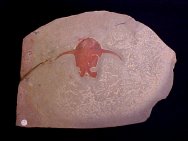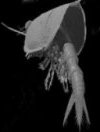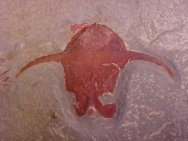|  Phyllocarids
are one of the lesser known crustaceans from the Cambrian, and
where the earliest animals to take advantage of minerals to evolve
hard shells for Phyllocarids
are one of the lesser known crustaceans from the Cambrian, and
where the earliest animals to take advantage of minerals to evolve
hard shells for  protection
as predators were also evolving. Phyllocarid had a large protective
carapace that shielded anterior body parts.
This carapace hinged in a manner on the dorsal edge pretty much
like a bivalve. Phyllocarid fossils are normally only the carapace,
with soft tissue only very rarely preserved, but such Burgess
Shale-type preservation is also found in the House Range of Utah
Cambrian site, as seen here. Mineralization has rendered this
specimen quite attractive, and exhibiting contrast seldom seen
in soft-bodied fossils of Utah. This dorsal view shows the arms
the animal used for stabilization. Wheeler Shale Formation taphonomy
studies have revealed how some layers preserve soft-bodied organisms,
normally with an absence of trilobites, while others preserve
trilobites, normally without other fauna with soft parts
preserved. protection
as predators were also evolving. Phyllocarid had a large protective
carapace that shielded anterior body parts.
This carapace hinged in a manner on the dorsal edge pretty much
like a bivalve. Phyllocarid fossils are normally only the carapace,
with soft tissue only very rarely preserved, but such Burgess
Shale-type preservation is also found in the House Range of Utah
Cambrian site, as seen here. Mineralization has rendered this
specimen quite attractive, and exhibiting contrast seldom seen
in soft-bodied fossils of Utah. This dorsal view shows the arms
the animal used for stabilization. Wheeler Shale Formation taphonomy
studies have revealed how some layers preserve soft-bodied organisms,
normally with an absence of trilobites, while others preserve
trilobites, normally without other fauna with soft parts
preserved.
Also
See: Utah Cambrian Explosion
Fossils
References:
Brooks,
H.K., and Caster, Kenneth E. 1956. Pseudoarctolepis sharpi, N.
gen., N. sp (Phyllocarida), from the Wheeler Shale of Utah. Journal
of Paleontology, Vol. 30, No. 1 pp. 9-14. |

 protection
as predators were also evolving. Phyllocarid had a large protective
carapace that shielded anterior body parts.
This carapace hinged in a manner on the dorsal edge pretty much
like a bivalve. Phyllocarid fossils are normally only the carapace,
with soft tissue only very rarely preserved, but such Burgess
Shale-type preservation is also found in the House Range of Utah
Cambrian site, as seen here. Mineralization has rendered this
specimen quite attractive, and exhibiting contrast seldom seen
in soft-bodied fossils of Utah. This dorsal view shows the arms
the animal used for stabilization. Wheeler Shale Formation taphonomy
studies have revealed how some layers preserve soft-bodied organisms,
normally with an absence of trilobites, while others preserve
trilobites, normally without other fauna with soft parts
preserved.
protection
as predators were also evolving. Phyllocarid had a large protective
carapace that shielded anterior body parts.
This carapace hinged in a manner on the dorsal edge pretty much
like a bivalve. Phyllocarid fossils are normally only the carapace,
with soft tissue only very rarely preserved, but such Burgess
Shale-type preservation is also found in the House Range of Utah
Cambrian site, as seen here. Mineralization has rendered this
specimen quite attractive, and exhibiting contrast seldom seen
in soft-bodied fossils of Utah. This dorsal view shows the arms
the animal used for stabilization. Wheeler Shale Formation taphonomy
studies have revealed how some layers preserve soft-bodied organisms,
normally with an absence of trilobites, while others preserve
trilobites, normally without other fauna with soft parts
preserved.